Finding Scale Factors
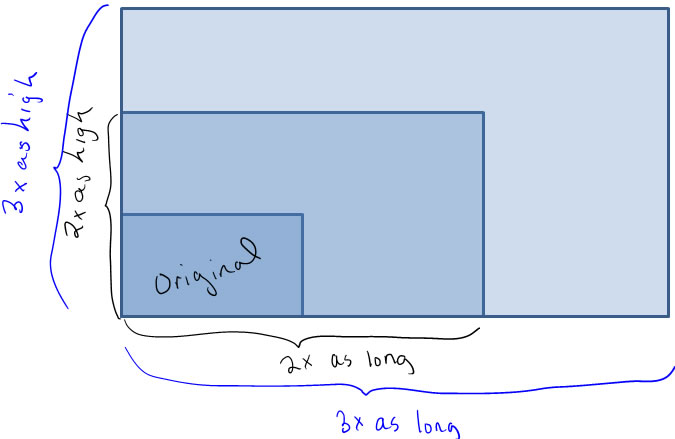 |
So far, most of the similar figures we've worked with had a scale factor of 2 or 3 or 4--nice whole numbers.
Recap: If there's a similar figure with a scale factor of 2, then:
- the length of the larger one is 2 times the length of the smaller one,
- the height of the larger one is 2 times the height of the smaller one,
- the perimeter and any other lengths are 2 times the length of the smaller one.
- The area is 4=2x2 times the area of the smaller one because area is a 2D measurement and the object scales up by the same amount in each dimension.
|
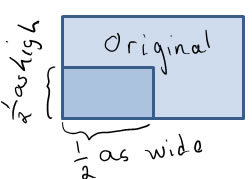 |
But there's no reason why a scale factor has to be a whole number. A rectangle could be scaled down by a scale factor of 1/2, or up by a scale factor of 1 1/3.
If you scale down by a scale factor of 1/2, then
- the length of the smaller one is 1/2 of the length of the original one,
- the height of the smaller one is 1/2 of the height of the original one,
- the perimeter and any other lengths are1/2 of the length of the original one.
- The area is 1/4=(1/2)x(1/2) the area of the original one: area is a 2D measurement and the object scales down by the same amount in each dimension.
|
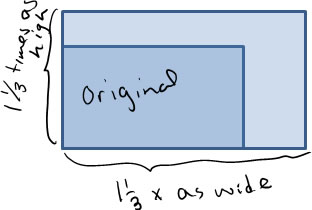 |
If you scale up by a scale factor of 1 1/3, then
- the length of the new one is 4/3 times the length of the original one,
- the height of the new one is 4/3 times the height of the original one,
- the perimeter and any other lengths are 4/3 times the length of the original one.
- The area is 16/9=(4/3)x(4/3) times the area of the original one.
|
Finding scale factors
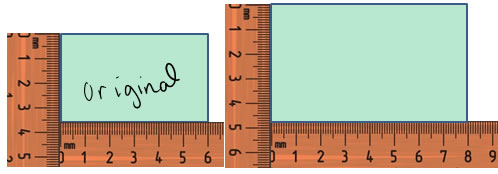
Here we have a pair of rectangles, and some questions:
- Are they similar?
- If they are similar what is the scale factor?
The original rectangle has length 6 cm and height 3.6 cm. The changed rectangle has length 8 cm and height 4.8 cm.
- To find a scale factor we divide, or make a fraction from the lengths.
- The new length should be in the numerator, and be divided by the original length (in the denominator)
- It often helps to simplify the fractions, so we can compare them.

The scale factor is the fraction made by comparing the two side lengths. If the scale factors are the same in both dimensions, then the two rectangles are proportional (proportional = similar).
- These two rectangles are similar
- The scale factor (from the original to the new rectangle) is 4/3.
4/3 being the scale factor means that:

Another example:
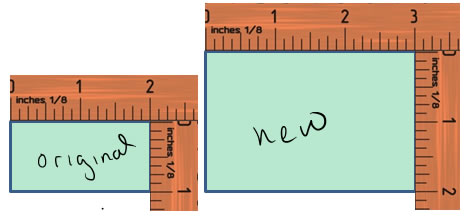
Again, we want to answer these questions about these two rectangles:
- Are they similar?
- If they are similar what is the scale factor?
The original rectangle has length 2 inches and height 1 inch. The new rectangle has length 3 inches and height 2 inches.
To find scale factors we make fractions:

These scale factors are different, so the rectangles are not proportional.
The rectangles should look different (non-proportional) to your eyes, but it is a common misconception that you can get similar shapes by adding the same amount to both sides.
An example with a shape that's not a rectangle:
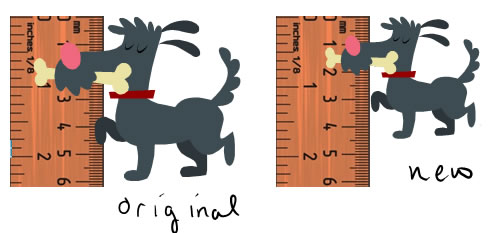
In this problem you are given that the dogs are proportional. The original dog is 6 cm tall, and the new dog is 4.5 cm tall.
- What is the scale factor?
- If you are given that the original dog's body (chest to tail) is 4 cm long. How long is the body of the new dog?
- If you are given that the tail of the original dog is 2 cm long. How long is the tail of the new dog?
- If you area given that the new dog is 6 cm long, how long is the original dog?
- If you are given that the new bone is 2.7 cm long, how long is the original bone?
- If you are given that the area of the original dog is 20 square cm, what is the area of the new dog?
To find the scale factor, we need to compare the lengths of the two dogs (since that's the information we know)

To change a length from the original to the new one, multiply by the scale factor:
Body size:

Tail length:

To change a length from the new one to the original, you can think of this as dividing by the scale factor, or you can invert the scale factor to get the scale factor from new to original.
Total dog length:

Bone length:

To find the new area, multiply by the scale factor twice:









